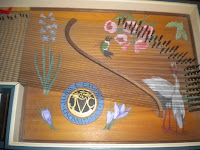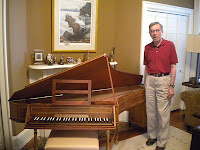



I am spending this month in Montreal, playing with the talented musicians of Matthew White’s ensemble Les Voix Baroques. Lucky me, I am staying with Margaret Little, a Montreal-based viola da gamba player, who is also in this concert and took the time to tell me about her life in early music. Margaret is one-half of the duo Les Voix humaines (www.lesvoixhumaines.org), whom anyone who has taken a few minutes to peruse the early music section of a CD store would recognize from their numerous recordings (around 30!).
Margaret grew up in a musical family. Her father was an organist and choral conductor who collaborated with the Montreal Consort of Viols with his choir. When Margaret was only eleven years old, she attended a music camp as a violinist, where she studied viola da gamba with Gian Lyman Silbiger. Margaret fell in love with the viol and its music and returned to Montreal determined to pursue her newfound interest. She saved the money for her first treble viol by teaching guitar lessons. (Remember, she was only eleven!)
Margaret met Susie Napper (the other half of Les Voix humaines) after Susie had moved from San Francisco to Montreal. They both had daughters the same age, so they met so the girls could play together. The moms did, too! This was how a magical, musical friendship through Les Voix humaines was born! Margaret says that their main interest is communicating and expression through their music. Their recording career began with their love of the music of St. Colombe. (Many of you may remember St. Colombe as the father/viol player in the movie Tous les Matins du Monde.) These duos are extremely esoteric, and they spent much time figuring out this complicated music and recorded all 67 of them on four double CD’s. They have a good relationship with their recording label, ATMA, and occasionally ATMA will offer suggestions for recordings or help with long-range plans.
Margaret and Susie spend a lot of time together for each project to try new things out and let the music grow and develop. Now, an important part of their musical life is in making arrangements of music for two viols or viol consort. They hope to make these clever arrangements available to the public! They also collaborate with other artists, such as Wieland and Bart Kuijken, Suzie LeBlanc, and viol players in consort. Les Voix humaines has participated in the Montreal Baroque Festival (see www.montrealbaroque.com).
Initially, they performed concerts in Susie’s home in a series of three to four concerts each year. Susie would cook amazing food to accompany these programs. Later, they moved the series to a church in Montreal. Margaret and Susie obtained an agent in 1994 to give them more opportunities to play. They have traveled all over the world with their music: Australia, New Zealand, Mexico, the U.S., throughout Canada, Israel, Japan, China, England, France, Belgium, Holland, Poland, and the Czech Republic. In the U.S., they have performed in Honolulu, St. Paul, St-Cloud, St-Croix, Tucson, Colorado Springs, Seattle, San Francisco, San Diego, Los Angeles, New York City, Cambridge, and Boston. They often coordinate these programs with lectures and workshops, often in cooperation with the Viola da Gamba Society of America.
Les Voix humaines has some goals for the future that we can look forward to. This year will feature consort music by Trabaci, as well as their focus on free improvisation. They will record Bach’s “Art of Fugue” and a duo Bach program – Susie’s arrangement of his Italian concerto for two bass viols.
Montreal is an exciting city, where there is so much early music happening. There are approximately twelve early music ensembles or series in this city! Margaret is one of the people who paved the way for this type of environment, and she is investing in its continued success through the collaborative development of a parent organization, Montreal Baroque. They are developing a website with links to performers and groups and a calendar for all early music performances in the city to help avoid planning conflicts for ensembles, but also to publicize concerts. The society may invite groups from abroad, will mentor young groups, and may offer a series for local groups without their own regular series.
Margaret teaches viola da gamba and Baroque ensemble at the University of Montreal. She primarily plays viol, but she also enjoys the Baroque viola and often performs both instruments in one concert. Margaret recorded a CD for unaccompanied viol and has many solo recitals planned with Montreal lute player Sylvain Bergeron. Her favorite music is sacred music with singers, like the Bach Passions or Christmas Oratorio. She commented, “I like being a part of a big group celebration of things spiritual.” Through her investments in making recordings, concerts at home and abroad, teaching privately and at university, ensuring the city’s future in early music with Montreal Baroque, and future musical goals, she is certainly involved in a big group celebration!






